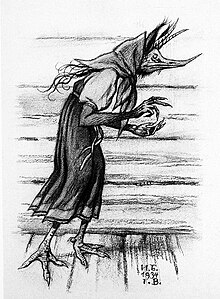Kikimora



Kikimora (Russian: кики́мора, IPA: [kʲɪˈkʲimərə]) is a legendary creature, a female house spirit in Slavic mythology. Her role in the house is usually juxtaposed with that of the domovoy, whereas one of them is considered a "bad" spirit, and the other, a "good" one. When the kikimora inhabits a house, she lives behind the stove or in the cellar, and usually produces noises similar to those made by the mice in order to obtain food. Kikimory (in plural) were the first traditional explanation for sleep paralysis in Russian folklore.
Etymology
The word kikimora may have derived from the Udmurt (Finno-Ugric) word kikka-murt, meaning scarecrow (literally bag-made person), although other etymological hypotheses also exist. The OED links mora with the mare of nightmare; moreover, inconclusive linguistic evidence suggests that the French word cauchemar might have also derived from the same root.[1]
In Polish folklore, mora are the souls of living people that leave the body during the night, and are seen as wisps of straw or hair or as moths. Accordingly, Polish mora, Czech můra denote both a kind of elf or spirit as well as a "sphinx moth" or "night butterfly".[2] Other Slavic languages with cognates that have the double meaning of moth are: Kashubian mòra,[3] and Slovak mora.[4]
In Slovene and Croatian, mora refers to a "nightmare". Mora or Mara is one of the spirits from ancient Slav mythology. Mara was a dark spirit that takes a form of a beautiful woman and then visits men in their dreams, torturing them with desire, and dragging life out of them. In Serbia, a mare is called mora, or noćnik/noćnica ("night creature", masculine and feminine respectively).[5] In Romania they were known as Moroi.
Features and behaviours
It is a common belief that mora enters the room through the keyhole, sits on the chest of the sleepers and tries to strangle them (hence moriti, "to torture", "to bother", "to strangle"). To repel moras, children are advised to look at the window or to turn the pillow and make a sign of cross on it (prekrstiti jastuk); in the early 19th century, Vuk Karadžić mentions that people would repel moras by leaving a broom upside down behind the door, or putting their belt on top of their sheets, or saying an elaborate prayer poem before they go to sleep.[6]
There are two different kinds of Kikimoras. The one that comes from the forest is married to the Domovoi. The other one comes from the swamp (Russian: кики́мора боло́тная) and is married to Leshy. It is said that she can be identified by her wet footprints. When home builders wanted to cause harm to someone buying a house, they would bring in Kikimora. Once she is inside, it is difficult to get her to leave.
Swamp Kikimora was described as small, ugly, hunchbacked, thin, and scruffy old woman with pointed nose and disheveled hair. She was said to use moss and grass as her clothes. It was believed that she frightens people, knocks travelers off the road, and also kidnaps children.[7]
There is a Russian bailichka about one swamp Kikimora, who loved to brew beer. Her name was Baba Bolotnitsa. When she was brewing beer, fog rose over the river (or swamp).[8]
When the house is in order, Kikimora looks after the chickens and housework. If not, she whistles, breaks dishes, and makes noises at night. She also comes out at night to spin thread.[9]
The legend is the basis of Kikimora (op. 63), a tone poem for orchestra by Anatoly Lyadov. Lyadov wrote that she "grows up with a magician in the mountains. From dawn to sunset the magician’s cat regales Kikimora with fantastic tales of ancient times and faraway places, as Kikimora rocks in a cradle made of crystal. It takes her seven years to reach maturity, by which time her head is no larger than a thimble and her body no wider than a strand of straw. Kikimora spins flax from dusk and to dawn, with evil intentions for the world."[10]
The Kikimora is mentioned by Russian "New Age" writer Vladimir Megre in The Space of Love, Book 3 of his "Ringing Cedars" series. Megre likens a man who marries unwisely based on looks and fashion to one who marries a Kikimora. A footnote in the English version describes the Kikimora as a malevolent female ghost said to attach itself to a particular house and disturb the inhabitants, males in particular. By extension, the term may also suggest an ugly woman in shabby clothing, ill-tempered and grumbling, striving to make the life of her husband (and men in general) unbearable.[11]
In 1988, Kirill Eskov discovered and described a new genus and species of sheetweaver spider, Kikimora palustris after this spirit.
References
- ^ "Mare". OED. Retrieved April 22, 2012.
- ^ Grimm 1883, TM 2, 464, note2
- ^ Bernard Sychta. Słownik gwar kaszubskich na tle kultury ludowej, Ossolineum, Wrocław - Warszawa - Kraków 1969, tom III, pp. 102-105
- ^ "Mora". KSSJ. Retrieved September 5, 2016.
- ^ Pócs 1999, p. 33 gives the feminine form.
- ^ Karadžić, Vuk (1898) [1818], Srpski rječnik, ISBN 9789639116184
- ^ Cherneva, N (2013). О прецедентных единицах русской народной сказки [About the precedent units of the Russian folk tale] (PDF) (in Russian).
- ^ Puhova, Tatyana (2009). Народная культура и проблемы её изучения. Сборник статей. Материалы научной региональной конференции 2008 г [Folk culture and the problems of its study. Digest of articles. Materials of the scientific regional conference (2008 year)] (in Russian). Voronezh: Voronezh State University. ISBN 978-5-98222-484-2.
- ^ "Polish Supernatural Spirits". Archived from the original on 2009-10-26.
- ^ Glass, Herbert. "Anatoly Liadov: Kikimora". Philpedia. Los Angeles Philharmonic Orchestra. Archived from the original on 26 October 2014. Retrieved 28 December 2011.
- ^ Megré, Vladimir (2008). Sharashkin, Dr. Leonid (ed.). The Space of Love (The Ringing Cedars, Book 3). Kahului, Hawaii: Ringing Cedars Press. p. 156. ISBN 978-0-9801812-2-7. OCLC 224907446.
